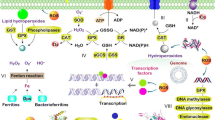Abstract
Sinorhizobium fredii RT19, a strain of freeliving bacteria, was subjected to salt shock and its protein expression profiles were analyzed by differential display proteome approaches. The results of separation by two-dimensional polyacrylamide gel electrophoresis (2D PAGE) showed that the number of resolved proteins was 481, 465 and 424, corresponding to salt-free control, 5 and 50 min 1 mol/L salt treatment, respectively. Among the resolved proteins, 82 in total had altered expression in response to salt-shock stress. 26 out of the 82 proteins were induced and 23 were completely inhibited, while 12 were up-regulated and 21 down-regulated in response to salt shock. In addition, the appearance of differentially displayed proteins responding to different salt shock periods is also reported. The identity of the 26 induced proteins was revealed by matrix assisted laser desorption/ionization time-of-flight mass spectrometry (MALDI-TOF/MS) followed by database searching. Among them, 20 were assigned to proteins with known functions. Their roles in response to salt shock stress are discussed.
Similar content being viewed by others
References
Ordovilla, M. P., Ligero, F., Lluch, C., The effect of salinity on N fixation and assimilation inVicia faba, J. Exp. Bot., 1994, 45: 1483–1488.
Talibart, R., Jebbar, M., Gouesbet, G. et al., Osmoadaptation in rhizobia: Ectoine-induced salt tolerance, J. Bacteriol., 1994, 176 (17): 5210–5217.
Zahran, H. H.,Rhizobium-Legume symbiosis and nitrogen fixation under severe conditions and in an Arid Climate, Microbiology and Molecular Biology Reviews, 1999, 63(4): 968–989.
Mange Φ Steras, Rudulier, L. D., Presence of a gene encoding choline sulfatase inSinorhizobium meliloti bet operon: Choline-O-sulfate is metabolized into glycine betaine, Proc. Natl. Acad. Sci. USA, 1998, 95: 11394–11399.
Alexandre, B., Karine, M., Laurence, D.,BetS is a major glycine betaine/proline betaine transporter required for early osmotic adjustment inSinorhizobium meliloti, J. Bacteriol., 2002, 184(10): 2654–2663.
Shen, S. H., Matsubae, M., Takao, T. et al., Aproteomic analysis of leaf sheaths from rice, J. Biochem., 2002, 132(4): 613–620.
Xia, S. H., Wang, M. R., Cai, Y. Y., Tow dimensional electrophoresis technology in proteomics, The Fascicule of Overseas Medicine and Genetics, 2001, 24 (6): 331–336.
Botsford, J. L., Analysis of protein expression in response to osmotic stress inEscherichia coli, FEMS Microbiol. Lett., 1990, 72: 355–360.
Bian, X. L., Ge, S. C., Yang, S. S., Subcloning and sequencing of DNA fragment related to salt tolerance inSinorhizobium fredii RT19, Acta Genetica Sinica, 2000, 27 (10): 925–931.
O’Farrell, P. H., High-resolution two-dimensions electrophoresis of proteins, J. Biol. Chem., 1975, 250: 4007–4021.
Guo, Y. J., Experimental Technique for Protein Electrophoresis, Beijing: Science Press, 2001.
Rüberg, S., Tian, Z. X., Krol, E. et al., Construction and validation of a Sinorhizobium meliloti whole genome DNA microarray: genome-wide profiling of osmoadaptive gene expression, J. Biotech., 2003, 106: 255–268.
Ducché, O., Trémoulet, F., Glader, P. et al., Salt stress proteins induced inListeria Monocytogenes, Applied and Environmental Microbiology, 2002, 68(4): 1491–1498.14.
Ruepp, A., Müller, H. N., Lottspeich, F. et al., Catabolic ornithine transcarbamylase ofHalobacterium halobium(salinarium): Purification, characterization, sequence determination, and evolution, J. Biol. Chem., 1995, 177(5): 1129–1136.
Nogales, J., Campos, R., BenAbdelkhalek, H. et al.,Rhizobium tropici genes involved in free-living salt tolerance are required for the establishment of efficient nitrogen-fixing symbiosis withPhaseolus vulgaris, MPMI, 2002, 15(3): 225–232.
Walt, A., Kahn, M. L., ThefixA andfixB gene are necessary for Anaerobic Carnitine reduction inEscherichia coli, J. Bacteriol., 2002, 184(14): 4044–4047.
Mendum, M. L., Smith, L. T., Characterization of glycine betaine porter I fromListeria monocytogenes and its roles in salt and chill tolerance, AEM, 2002, 68(2): 813–819.
Lagares, A., Hozbor, D. F., Niehaus, K. et al., Genetic characterization of aSinorhizobium meliloti chromosomal region involved in lipopolysaccharide biosynthesis, J. Bacteriol., 2001, 183(4): 1248–1258.
Münchbach, M., Dainese, P., Staudenmann, W. et al., Proteome analysis of heat shock protein expression inBradyrhizobium japonicum, Eur. J. Biochem., 1999, 263: 39–48.
Author information
Authors and Affiliations
Corresponding author
About this article
Cite this article
Qi, S., Yang, P., Jing, Y. et al. A proteomic analysis of bacterial strainSinorhizobium fredii RT19 subjected to salt shock. Chin.Sci.Bull. 49, 1828–1833 (2004). https://doi.org/10.1007/BF03183409
Received:
Accepted:
Issue Date:
DOI: https://doi.org/10.1007/BF03183409




